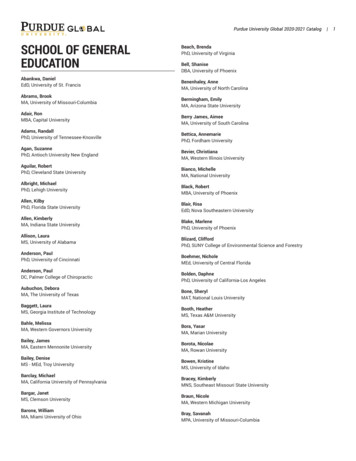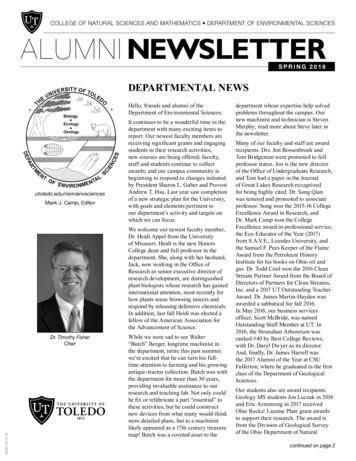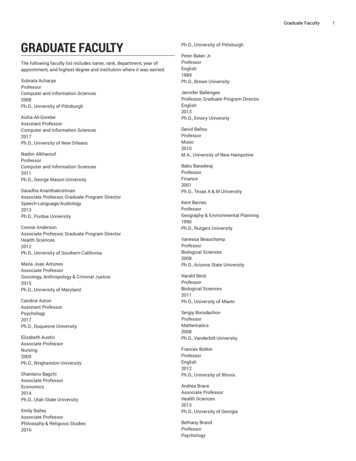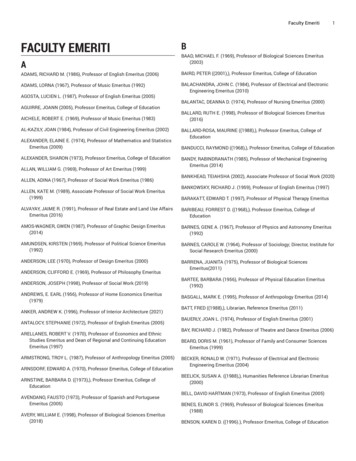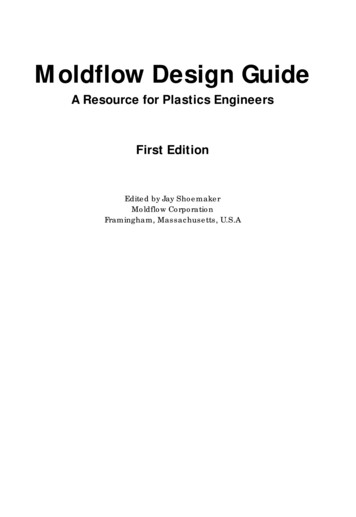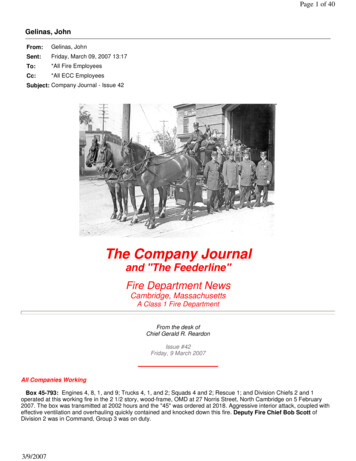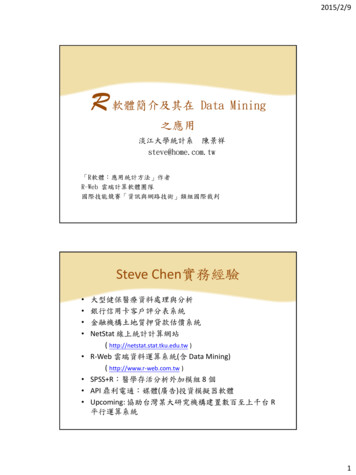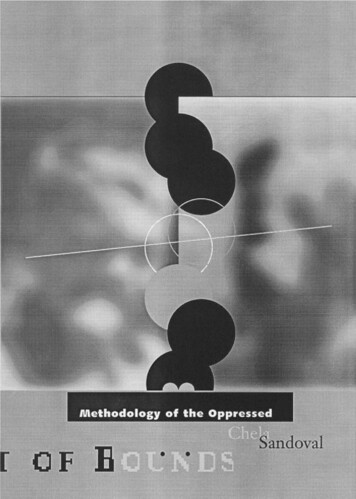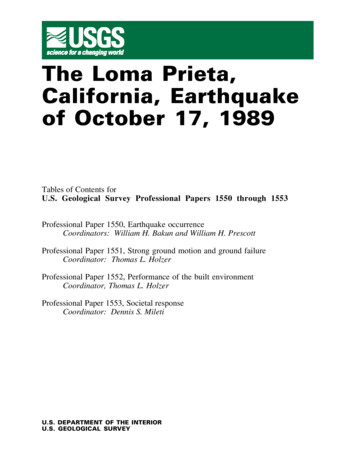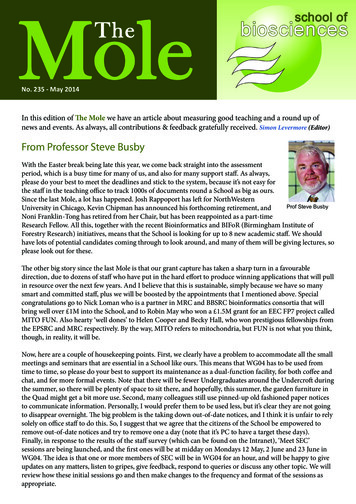
Transcription
No. 235 - May 2014In this edition of The Mole we have an article about measuring good teaching and a round up ofnews and events. As always, all contributions & feedback gratefully received. Simon Levermore (Editor)From Professor Steve BusbyWith the Easter break being late this year, we come back straight into the assessmentperiod, which is a busy time for many of us, and also for many support staff. As always,please do your best to meet the deadlines and stick to the system, because it’s not easy forthe staff in the teaching office to track 1000s of documents round a School as big as ours.Since the last Mole, a lot has happened. Josh Rappoport has left for NorthWesternProf Steve BusbyUniversity in Chicago, Kevin Chipman has announced his forthcoming retirement, andNoni Franklin-Tong has retired from her Chair, but has been reappointed as a part-timeResearch Fellow. All this, together with the recent Bioinformatics and BIFoR (Birmingham Institute ofForestry Research) initiatives, means that the School is looking for up to 8 new academic staff. We shouldhave lots of potential candidates coming through to look around, and many of them will be giving lectures, soplease look out for these.The other big story since the last Mole is that our grant capture has taken a sharp turn in a favourabledirection, due to dozens of staff who have put in the hard effort to produce winning applications that will pullin resource over the next few years. And I believe that this is sustainable, simply because we have so manysmart and committed staff, plus we will be boosted by the appointments that I mentioned above. Specialcongratulations go to Nick Loman who is a partner in MRC and BBSRC bioinformatics consortia that willbring well over 1M into the School, and to Robin May who won a 1.5M grant for an EEC FP7 project calledMITO FUN. Also hearty ‘well dones’ to Helen Cooper and Becky Hall, who won prestigious fellowships fromthe EPSRC and MRC respectively. By the way, MITO refers to mitochondria, but FUN is not what you think,though, in reality, it will be.Now, here are a couple of housekeeping points. First, we clearly have a problem to accommodate all the smallmeetings and seminars that are essential in a School like ours. This means that WG04 has to be used fromtime to time, so please do your best to support its maintenance as a dual-function facility, for both coffee andchat, and for more formal events. Note that there will be fewer Undergraduates around the Undercroft duringthe summer, so there will be plenty of space to sit there, and hopefully, this summer, the garden furniture inthe Quad might get a bit more use. Second, many colleagues still use pinned-up old fashioned paper noticesto communicate information. Personally, I would prefer them to be used less, but it’s clear they are not goingto disappear overnight. The big problem is the taking down out-of-date notices, and I think it is unfair to relysolely on office staff to do this. So, I suggest that we agree that the citizens of the School be empowered toremove out-of-date notices and try to remove one a day (note that it’s PC to have a target these days).Finally, in response to the results of the staff survey (which can be found on the Intranet), ‘Meet SEC’sessions are being launched, and the first ones will be at midday on Mondays 12 May, 2 June and 23 June inWG04. The idea is that one or more members of SEC will be in WG04 for an hour, and will be happy to giveupdates on any matters, listen to gripes, give feedback, respond to queries or discuss any other topic. We willreview how these initial sessions go and then make changes to the frequency and format of the sessions asappropriate.
School news60th Mammal Society ConferenceTwo of our undergraduate students presented posters at the 60th Mammal SocietyConference in April based on their BSc final year project work with Julia Myatt.Chloe Walton’s work looked at the social interactions in a mixed-species enclosure ofcoatis and bush dogs, whereas Chris Duncan looked at social network dynamics incaptive chimpanzee groups. This work was carried out together with Twycross Zooand provides them with information about their group dynamics, key when merginggroups or for monitoring how they respond to changes- such as the arrival of newbush dog pups! It was a great experience for Chloe and Chris (even though theywere 2 of only 3 undergraduates) and they also got the chance to see some big namespresenting such as Prof David Macdonald head of Oxford WildCru. Both are hopingto go into research/conservation careers and attending the conference has enabledthem to start building their own social networks for the future!Chloe WaltonChris DuncanProfessor Emeritus recognised in New Year’s Honours ListDavid Morton was awarded a CBE in the New Year’s Honours for his “services to theUK and International Veterinary Profession especially Animal Welfare and Ethics” Hewas Director of the Biomedical Service Unit from 1989 to 2006 and Head of the Centrefor Biomedical Ethics, and is a Professor Emeritus in the School of Biosciences.Professor David MortonDistinguished Visiting FellowProfessor Jeffrey Boore, from the University of California Berkeley, will be aDistinguished Visiting Fellow of the University’s Institute for Advanced Studies fromMay 16 through July 12. Professor Boore is experienced in the fields of genomicsand evolution and will collaborate with his host, Professor John Colbourne, aswell as others, to further develop models for understanding genomic responses toenvironmental stresses.Professor Boore brings a diversity of experience, including seven years as partof the Senior Management and Head of Evolutionary Genomics at the US DOEJoint Genome Institute, one of the world’s largest genome sequencing facilities,Professor Jeffrey Booreand founder and Chief Executive of Genome Project Solutions, a private companyspecializing in genomics research. Professor Boore’s work is very broad, and includes the study ofmitochondrial and chloroplast genomes, the use of “genome-level” characters for phylogeny, evolutionarytransfer of genes among organisms, patterns of genome rearrangements and whole genome duplications,RNA editing, the development of software and databasing schemes for whole genome comparisons, and thewhole nuclear genomes of a tunicate, a crustacean, several oomycetes, a glaucophyte, a moss, a butterfly, aleech, a polychaete, a limpet, a snail, and several algae for biofuels production.
Carina Hellberg (1967-2014)A tree-planting ceremony was held in the Biosciences Quad on 28 March in memory of Dr Carina Hellberg,Reader in Molecular Cell Biology in the School, who died in the Queen Elizabeth Hopsital on Friday 14thMarch.Carina joined us in September 2011, having previously been a Group Leader at the Ludwig Institute inUppsala in Sweden. Although her time with us was quite short, she made a big impression, and she will begreatly missed. Carina’s family was represented on the day by her brother Bjorn.The Swedish inscription on Carina’s plaque reads “Having a loving sister is having a friend for life”
BioSystems and Environmental ChangeMark ViantA contingent from UoB including Sally Wiley, Xavier Rodde, Mark Viant and John Colbourne recentlyvisited the Joint Research Centre (JRC) in Ispra, northern Italy, to forge a collaboration around chemicaland nanomaterial safety. The JRC are the lead organisation in Europe for providing independent scientificadvice to the European Commission. Our visit on 12-13 March 2014 initiated this new and importantalliance, which will strengthen the translation and impact of our environmental research in the BECtheme into European policy development. We were joined by colleagues from the US National Institute ofEnvironmental Health Sciences (Dr Jonathan Freedman) and the BGI (Dr Yong Zhang). A longer follow upvisit is planned for early June.The UoB contingent outside the Joint Research Centre in Ispra, Northern ItalyFirst ‘Circadian Advice Bureau’ and ‘Sleep Clinic’ launchedat the University of BirminghamDr Roland BrandstaetterBiological rhythms and sleep research are currently amongst the most importantareas in public health. Sleep pathologies have reached epidemic proportions over thepast decades and a large number of people worldwide suffer from chronic ‘circadian’disruptions, i.e. conditions describing the increasing discrepancy between the timing ofour internal biological body clocks and that of our social environment. These includeDr Roland Brandstaettervarious forms of sleep disturbances and rhythm disorders, such as ‘social jet lag‘, i.e. thedisruption of an individual’s sleep/wake rhythm due to social constraints (e.g. work hours).The newly launched ‘Circadian Advice Bureau’ and ‘Sleep Clinic’ are steps in the direction of increasingpublic understanding of science and directly linking the academic world with the real world. Impact ofresearch does not always have to be ‘indirect’, it can be directly applied, and this is what this new appliedresearch in the School of Biosciences is all about.Read more about this on the School Website
A Growth Spurt at 1,500 Years OldFollowing the recent resuscitation of a sample of moss which turned out to be more than1,500 years old, Dr Luisa Orsini of the School of Bisociences describes, in a New YorkTimes article entitled “A Growth Spurt at 1,500 Years Old” how it may be possible to usewhatever is stored in ice or sediment as a sort of backup for biodiversity.Dr Orsini goes on to say “one has to be really, really careful introducing something fromthe past.”Dr Luisa OrsiniRead the full New York Times article hereBiosciences SeminarsAs always, the list of forthcoming events and seminars is available on the School of Biosciences website - andthere is a full list of forthcoming seminars as well as available seminar slots on the school Intranet pages.BUAFTA success for College Web Manager (that’s me!)Simon LevermoreI was recently very humbled to win a BUAFTA award for the “Idea of the Year” for the Marketing and WebTeam’s initiative of producing the series of Research in 60 seconds videos. The fact that this happened on theFriday of the weekend of my 50th Birthday was cause for double celebration!This is me (white shirt, white hair!) receiving myaward from Mr Gresham of Gresham Office Furniture,the sponsor of the Idea of the Year award.I would like to take this opportunity to thank all myacademic colleagues in the College who ‘willingly’put themselves through the 60-second challenge. Theplan is to continue to roll-out this initiative across thecollege, so any volunteers who feel they could describetheir research for the lay audience in exactly oneminute please feel free to contact me: s.j.levermore@bham.ac.uk.You can see the gallery of 60-second Research videos here.There is a small write-up about the award nomination on the BUAFTA page here.Module in a minute - more or lessFollowing on from the series of research videos, the CollegeMarketing and Web Team are now in the process of producinga series of videos wherein academics describe a module thatthey are leading or teaching on. These videos are linked fromthe list of modules in each of the undergraduate Course Finderentries and have recently been emailed to offer holders inrecent ‘conversion’ emails.You can see the videos on the YouTube playlist here and anexample of how they are linked to a course profile here.
Measuring good teaching: the golden triangle of Learning outcomes,Assessment and Teaching DeliveryDr Jeremey PritchardThe academic world is changing, research funding is tight, career paths aredifferentiating, meaning that new ways of measuring the various strands of academicactivity are needed. As part of this new ways of confidently measuring teaching qualityare being sought. I argue that we now have an opportunity to strip down the teachingstructures in Universities and rebuild these firmly based on assessment and learningoutcomes, allowing development of systems for measuring teaching quality that arefunctional, transparent and realistic.Measuring researchDr Jeremy PritchardWe are comfortable with measuring research; we can measure grant income or the number of high impactpapers. These metrics may be clear but they are not necessarily the only measure of the impact of research,however they are currently the gold standard and widely accepted. As promotion opportunities change andteaching quality comes higher up the agenda, the need to measure teaching in a similar way as we do forresearch becomes ever more important. Like it or not, students are our customers and, while attracted froma distance to research led institutions, when they arrive it is the quality of the student experience, driven bythe teaching that dictates their satisfaction. Therefore a culture shift in how we perceive and value Universityteaching is now required.You are a good teacher – how do you know?Good teaching will flourish if rewarded. Being able to demonstrate good teaching is therefore important toencourage and disseminate good practice. Recognition and reward of good teaching at all levels can onlyimprove quality. Furthermore a high quality student experience will positively impact on the standing andperception of a university at all levels, including research.How do you demonstrate that you are a good teacher? While teaching in many institutions brings in moremoney than research, the loss of a good teacher does not have the same immediate impact on the financialbottom line as when the leader of a successful research group is head-hunted.What is good teaching? We are all expected to do good teaching and we are all aware of the good teachersaround us (as hopefully are the students) but how can it be measured? In particular how can we demonstratethat we are a good teacher to a promotions board with focussed experience of the clean metrics of researchsuccess?There are many candidates that could be used including; module evaluation questionnaires (MEQs), Studentsexam performance, National Student survey returns (NSS), employability figures, student recruitmentsuccess, league tables, volume of hours taught and publication of pedagological research to name a few.All these are however potentially confusing and are not all reliable. MEQS can be manipulated: what isgood for the student is not necessarily enjoyable for them. Many times we hear that an unpopular teachingactivity only became apparent as useful to students some years later. Exam performance is also not reliable;comparing modules can be like comparing apples and pears. Year on year trends may be indicative ofquality, but do not take into account different student cohorts or topics. Pedagogy research might provide analternative metric, but it is highly specialist, and most lecturers will struggle to deliver more than reflection oftheir own teaching practice.In research we are comfortable with external measures of quality using peer assessment to judge papers and
grants; can this be useful for measuring teaching quality? Clearly a mention by an external examiner may besuggestive but it is not comprehensive or systematic. Other external measures such as attendance at educationmeetings to present papers and talks may be valuable. However without further validation attendance alone isnot indicative of quality. External recognition of teaching quality, such as the HEA teaching fellowships, alsohave value, however these must be triaged to ensure that they truly represent a discriminatory measure ofquality and are not just box ticking required-elements. You can attend an education conference and presenta paper, box ticked, but were you any good? Did it make a difference and contribute to enhancing educationmore widely?What is University education for?So if the definition of good teaching is more complex than it first might appear, does it help if we drill downto the bedrock of the teaching: Good teaching is what delivers the correct outcome of a university education.This then naturally leads to the question of what a good university education is, or more precisely - What isUniversity for?The definition of a good university is at the root of defining good teaching. So what is a University educationfor? You can start with what comes out; graduates. They come in many shapes and sizes. How then is theirquality measured? Degree class seems a good starting point, but this is a crude measure.Delivering employable graduates is increasingly seen as a major role of University; clearly this depends onemployers needs but could be separated into generic skills and subject specific skills and knowledge. So howdoes the teaching process that produces university graduate actually deliver these attributes? What are thebasic processes that produce a graduate of defined quality? I suggest there are three interrelated parameters.1. Learning outcomes (LOs): The product of university is defined by the learning outcomes of theprogrammes and individual modules that make up their degrees. These LOs ultimately define thequalitative nature of the graduate.2. Assessment Criteria are the second plank, providing a quantification of how far, and therefore how ‘good’a candidate is in relation to the learning outcomes3. The teaching delivery that links LOs and assessment is the third component.It is my view that teaching delivery can only be properly evaluated in the context of the LOs and theirassessment criteria. Only then can evaluation of teaching delivery provide transparent, consistent evidence ofquality. As discussed above, teaching delivery can be assessed in many ways, these must be informed by theunderlying purpose of the teaching defined by fit-for-purpose LOs and their assessment criteria.I believe that a fundamental re-appraisal is needed to set in place a robust framework of measuring teachingquality. It would be a mistake to accrete further processes, like a sticking plaster, on top of a jumbled systemof LOs and their associated assessment criteria that have evolved in a different environment from where weare now: You wouldn’t start from here so let’s clean it up.So to conclude,1. The University education system is now qualitatively different from what it was even ten years ago2. Evaluation of good teaching is essential to deliver the enhanced student experience and quality ofgraduate that is now required3. Measuring good teaching must be discriminating, not box ticking4. The underpinning LOs and criteria should be re-evaluated before any measurement of teaching deliveryquality.It is my view that this can only be achieved with local and national consensus. It will require externalvalidation and acceptance by institutions that promotion boards need this help in evaluating teaching quality.
If this happens then academics will believe that teaching is valued; once critical mass is reached improvementin teaching quality will be self-sustaining. Thus teaching should be evaluated (or re-evaluated) in the lightof what universities are expected to, or expect to, produce and how the quality of the student product ismeasured.Updating your academic staff website profileYou can make changes to your academic staff profiles, for instance updating your publications, by using theonline editor as per the following instructions:1. Go to this link: tor.aspx2. Login using your normal University login details. You will see a page that looks similar to your live profilepage, but with editable fields.3. Make the necessary changes, and then click save. The page will automatically come through to us (theCollege Web Team) for publishing. If you need to make any other changes after you have clicked save, youare free to do so, and we will just receive the most recent version to publish.4. If you receive an email saying ‘your page has been revoked from approval’, this just means that we havegone into the page to correct any formatting or links that might have slipped, and will publish whencorrected.Please note: The editor will only allow you to update text. If the changes you need to make involve imagesyou will need to send the images, and details of where in your profile you need them to be, to SimonLevermore at s.j.levermore@bham.ac.uk.Caption competition (just for fun)Any suggestion of a caption for this!Send any captions to Simon Levermore ats.j.levermore@bham.ac.ukFrom issue 234 of The MoleThanks to Jeff Cole for“This member of IMI should have retired five years ago!”
A contingent from UoB including Sally Wiley, Xavier Rodde, Mark Viant and John Colbourne recently visited the Joint Research Centre (JRC) in Ispra, northern Italy, to forge a collaboration around chemical and nanomaterial safety. The JRC are the lead organisation in Europe for providing independent scientific advice to the European Commission.
